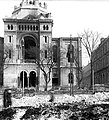Great Synagogue (Łódź)
 From Wikipedia - Reading time: 7 min
From Wikipedia - Reading time: 7 min
| Great Synagogue | |
|---|---|
Polish: Wielka Synagoga w Łodzi | |
 The former synagogue, undated postcard | |
| Religion | |
| Affiliation | Reform Judaism (former) |
| Ecclesiastical or organisational status | Synagogue (1887–1939) |
| Status | Destroyed |
| Location | |
| Location | Łódź, Łódź Voivodeship |
| Country | Poland |
Location of the destroyed synagogue in Łódź Voivodeship | |
| Geographic coordinates | 51°46′12″N 19°27′14″E / 51.77000°N 19.45389°E |
| Architecture | |
| Architect(s) | Adolf Wolff |
| Type | Synagogue architecture |
| Style | Romanesque Revival |
| Funded by |
|
| General contractor | Johann Steck |
| Groundbreaking | 1881 |
| Completed | 1887 |
| Destroyed | November 14, 1939 |
| Specifications | |
| Dome(s) | Four |
| Materials | Bricks |
The Great Synagogue of Łódź (Polish: Wielka Synagoga w Łodzi) was a former Reform Jewish congregation and synagogue, located in Łódź, in the Łódź Voivodeship of Poland. Designed by Adolf Wolff in the Romanesque Revival style and completed in 1887, the synagogue served as a house of prayer until World War II when it was destroyed by Nazis on November 14, 1939.
History
[edit]The synagogue was commonly referred to as The Temple.[1]
Prominent Łódż builder and architect Johann Steck (or Jan Sztek, 1851–1914)[2] carried out construction of the synagogue between 1881 and 1887, at the corner of ul. Zielona and al. Tadeusza Kościuszki (formerly ul. Spacerowa). The construction was funded principally by local industrialists, including Izrael Poznański, Joachim Silberstein and Karol Scheibler.
The synagogue was burned to the ground by the Nazis on the night of November 14, 1939, along with its Torah scrolls and interior fixtures.[3] The building was dismantled in 1940 and the site was subsequently used as a parking lot.
Other synagogues destroyed by the Nazis in Łódź included the Stara Synagogue, on November 15–16, 1939, and the Ezras Izrael Synagogue, also in November 1939.[3] Scorched walls were demolished in March 1940.
Gallery
[edit]-
Synagogue interior
-
The former synagogue in 1939
-
Commemoration stone on the former site
-
Obituary of Johann Steck
See also
[edit]References
[edit]- ^ Dobroszycki, Lucjan; Lourie, Richard (1987). The Chronicle of the Lodz Ghetto, 1941-1944. Yale University Press. p. 28.
- ^ Stefański, Krzysztof (2009). Ludzie Ktory Zbudwali Łódż. Leksykon architektów i budowniczych miasta (in Polish). Łódź: Księży Młyn Dom Wydawniczy. pp. 161–162. ISBN 978-83-61253-44-0.
- ^ a b Huberband, Shimon (1989). "The Destruction of the Synagogues in Lodz". In Adelson, A.; Lapidus, R.; et al. (eds.). Łódź Ghetto: Inside a Community Under Siege. New York.
{{cite book}}: CS1 maint: location missing publisher (link)
External links
[edit]![]() Media related to Great Synagogue in Łódź at Wikimedia Commons
Media related to Great Synagogue in Łódź at Wikimedia Commons
 KSF
KSF





